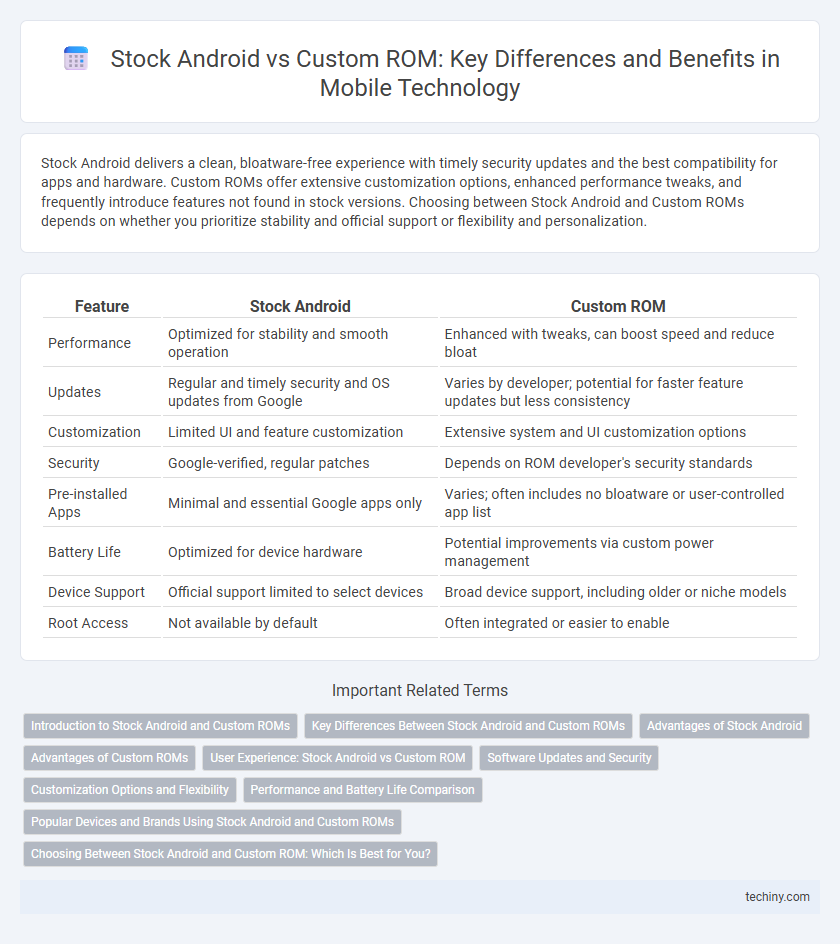Stock Android delivers a clean, bloatware-free experience with timely security updates and the best compatibility for apps and hardware. Custom ROMs offer extensive customization options, enhanced performance tweaks, and frequently introduce features not found in stock versions. Choosing between Stock Android and Custom ROMs depends on whether you prioritize stability and official support or flexibility and personalization.
Table of Comparison
| Feature | Stock Android | Custom ROM |
|---|---|---|
| Performance | Optimized for stability and smooth operation | Enhanced with tweaks, can boost speed and reduce bloat |
| Updates | Regular and timely security and OS updates from Google | Varies by developer; potential for faster feature updates but less consistency |
| Customization | Limited UI and feature customization | Extensive system and UI customization options |
| Security | Google-verified, regular patches | Depends on ROM developer's security standards |
| Pre-installed Apps | Minimal and essential Google apps only | Varies; often includes no bloatware or user-controlled app list |
| Battery Life | Optimized for device hardware | Potential improvements via custom power management |
| Device Support | Official support limited to select devices | Broad device support, including older or niche models |
| Root Access | Not available by default | Often integrated or easier to enable |
Introduction to Stock Android and Custom ROMs
Stock Android offers a clean, bloatware-free experience directly from Google, ensuring timely updates and optimal system stability. Custom ROMs provide users with enhanced customization, additional features, and extended device support beyond official releases. Choosing between Stock Android and custom ROMs depends on the need for pure performance versus personalized functionality in mobile technology.
Key Differences Between Stock Android and Custom ROMs
Stock Android features a clean, unmodified interface directly from Google, ensuring regular security updates and consistent performance across devices. Custom ROMs offer extensive customization options, enhanced features, and potential performance improvements but may lack official security patches and stability. The choice between Stock Android and Custom ROMs centers on prioritizing reliability and timely updates versus personalization and experimental functionalities.
Advantages of Stock Android
Stock Android offers a pure, bloatware-free user experience that ensures faster updates directly from Google, enhancing security and performance. Devices running Stock Android typically have better battery optimization and smoother operation due to the streamlined software. Furthermore, Stock Android provides superior compatibility with apps and advanced features like Google Assistant and Digital Wellbeing.
Advantages of Custom ROMs
Custom ROMs offer enhanced customization options, allowing users to tailor the Android interface and features to their specific preferences beyond the limitations of Stock Android. They frequently provide faster updates and access to the latest Android versions, improving security and performance on devices that no longer receive official updates. Furthermore, Custom ROMs often optimize system performance and battery life through advanced tweaks and remove bloatware pre-installed by manufacturers, resulting in a cleaner and more efficient user experience.
User Experience: Stock Android vs Custom ROM
Stock Android offers a clean, fast user experience with timely updates and minimal bloatware, enhancing device performance and reliability. Custom ROMs provide extensive customization options and additional features that can tailor the user interface and functionality to individual preferences but may introduce stability issues or delayed updates. Users prioritizing a smooth, consistent experience often prefer Stock Android, while those seeking personalized control and unique enhancements lean towards Custom ROMs.
Software Updates and Security
Stock Android provides faster and more consistent software updates directly from Google, ensuring timely security patches and the latest features. Custom ROMs offer expanded customization and extended device support but often rely on community developers, leading to irregular update schedules and potential security risks. Security in Stock Android benefits from official Google Play Protect integration, whereas Custom ROMs may require users to manually verify update sources to maintain system integrity.
Customization Options and Flexibility
Custom ROMs offer extensive customization options and flexibility, allowing users to modify system interfaces, install unique themes, and tweak performance settings beyond the limitations of Stock Android. These ROMs enable advanced features such as granular permission controls, custom kernels, and overclocking, which are rarely available on stock builds. Enthusiasts benefit from the ability to tailor their devices to specific use cases, boosting both functionality and user experience.
Performance and Battery Life Comparison
Stock Android offers a streamlined and bloat-free experience, resulting in smoother performance and better battery optimization due to its close-to-stock system updates and minimal background processes. Custom ROMs, while providing extensive customization and additional features, can sometimes introduce instability or increased resource consumption that negatively impacts both performance and battery life. Users seeking optimal efficiency typically benefit from Stock Android's disciplined memory management and less intrusive app permissions, leading to longer battery endurance and consistent speed.
Popular Devices and Brands Using Stock Android and Custom ROMs
Google Pixel, OnePlus, and Nokia are prominent brands known for using Stock Android, offering a clean, bloatware-free experience with timely updates. Custom ROMs like LineageOS and Paranoid Android are popular among users of devices such as Xiaomi, Samsung, and Sony, enabling extensive customization and performance enhancements. These ROMs extend device longevity and allow users to bypass manufacturer restrictions, appealing to enthusiasts who prioritize control and optimization.
Choosing Between Stock Android and Custom ROM: Which Is Best for You?
Stock Android offers a clean, secure, and regularly updated experience backed by Google, making it ideal for users prioritizing stability and timely security patches. Custom ROMs provide extensive customization, enhanced performance tweaks, and features not available on stock versions, appealing to advanced users seeking personalization and control. Choosing between them depends on your comfort level with technical modifications and the desire for either reliability or flexibility in your mobile technology experience.
Stock Android vs Custom ROM Infographic

 techiny.com
techiny.com